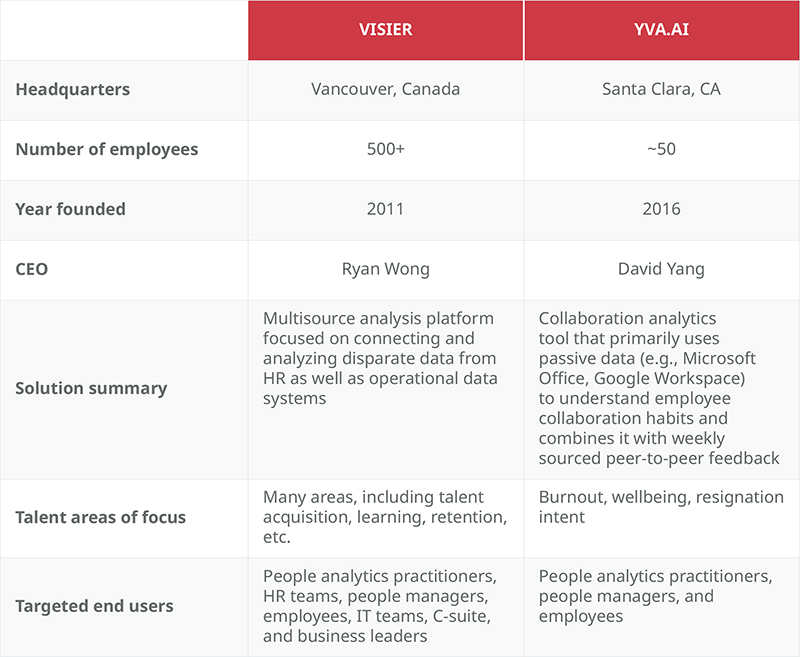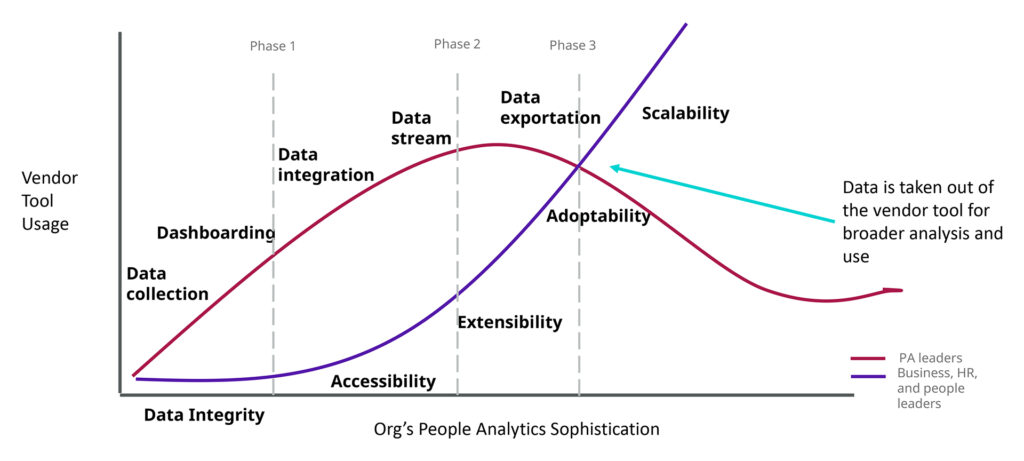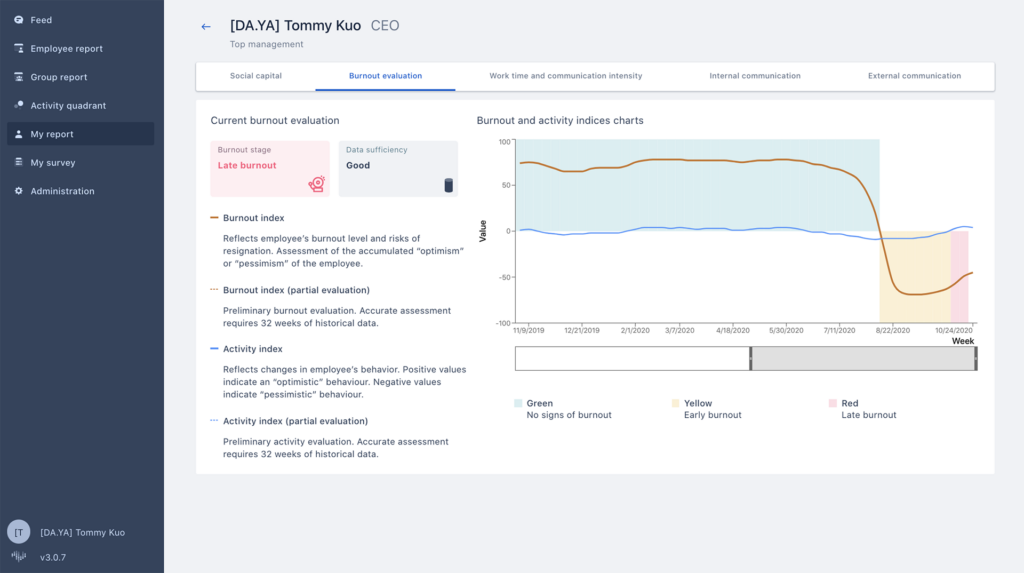Update: Visier Gets in the Collaboration Analytics Market with Yva.ai Purchase
May 31st, 2022
Update: We published this blog in early May when news of Visier’s acquisition of the assets of Yva.ai was announced. We were recently briefed by Visier leaders on the acquisition, and we had the chance to ask the questions we had originally laid out in the blog. We have republished this blog along with the responses. If you have already read this blog and would like to skip to the updates, please scroll down to the last section.
Last week, Visier announced its acquisition of the assets of Yva.ai (pronounced ee-vah, like the alien robot in Wall-E), an AI-driven collaboration analytics vendor. This is interesting news in our space because of what it says about:
- The shifting use cases in the PAT market
- The rising importance of continuous, passive data analytics
- The continued consolidation of people analytics tech
This blog took a little while longer to write than usual because there’s a lot to say about these two different technologies and the shifts within the market. In the below, we cover the following:
- Overview of Visier and Yva.ai
- Background on Multi-source Analysis Platforms (MSAPs) and shifting people analytics tech use cases
- What is a collaboration analytics tool?
- What is Yva.ai?
- Why did Visier acquire the assets of Yva.ai?
If you aren’t looking for any background on the space, feel free to skip bullets 2 and 3.
Overview of Visier and Yva.ai
Let’s begin with a quick review of who is who (see Figure 1). Visier is what we call a “multi-source analysis platform” (MSAP), meaning it connects data from existing HR systems (e.g., HRIS, LMS / LXP, TM) and other operational systems (e.g., sales or customer data) and enables robust analysis and distribution. Yva.ai is a collaboration analytics tool that combines data from corporate tools, such as Microsoft Office 365 and Microsoft Teams, Zoom, Slack, and other collaboration tools, and enhances it with weekly sourced peer-to-peer feedback.
Background on Multi-source Analysis Platforms (MSAPs)
Before we get to more specifics on Visier and Yva.ai, let’s first talk about what MSAPs are and their current opportunities and limitations. As mentioned above, MSAPs allow companies to integrate data from existing HR and other operational systems, analyze that data, and distribute insights about it at appropriate levels of security throughout the organization. These insights are used by people analytics and HR leaders, and, increasingly by business leaders, managers, and individual employees.
There is an incredible amount of power in this type of system. By bringing together disparate data, these systems can create a single, integrated source of data truth, which can then be used to answer critical questions about what is happening with the workforce. Our research shows that effectively using integrated people analytics data can help impact businesses in terms of millions and sometimes billions of dollars, as we wrote about in our report, Unlocking the Hidden C-suite Superpower: People Analytics. These types of significant business outcomes are typically the result of people analytics teams working to help answer strategic business questions, with the support of the CHRO and senior business leaders, who make the final decision.
Yet, the people analytics team is only so big in any organization and can only answer so many questions themselves. By putting data into the hands of more business leaders, managers, and employees, organizations could enable more people to make better, data-backed decisions about people, and thus better enable those organizations (and people!) to thrive. This is the dream that many of us in people analytics have for the future.
Shifting PAT Use Cases
Putting data in the hands of the masses is not just a dream for vendors – in fact, it is a necessity for their future. As shown in Figure 2 (a sneak peek into next week’s release of the People Analytics Tech study), we’ve found that the use cases for people analytics tech are changing. Specifically, as people analytics teams increase in sophistication, they use vendors – especially MSAPs – to integrate increasingly complex data. At some point, though, some of the people analytics teams will take this holistic, integrated data set out of the multi-source analysis platform and put it into a centralized data lake, doing less of their work in the platform. This allows those PA teams to do more sophisticated research and analysis.
Yet, that doesn’t mean MSAPs are no longer important – in fact, it is just the opposite. This is when these systems can become the most valuable. As the data become richer and more continuous (meaning they change and update on a continuous basis), they have increased value in terms of helping business leaders, managers, and employees make better decisions. MSAPs are superb at scaling and sharing data and insights across complex enterprises. Further, given the time that it takes organizations to adopt new technologies, it is just at this point (between Phase 2 and Phase 3 in Figure 2) that these technologies start to be adopted at the scale necessary to drive meaningful insights across the business.
However, for MSAPs, there is a stumbling block in achieving this dream of ubiquitous use: The data these systems integrate often doesn’t change frequently enough to entice senior business leaders, managers, or individual employees to want to look at it continuously (e.g., daily). (Sorry friends, I know some of you will disagree. However, our research shows that 17% and 8% of MSAPs are accessed daily by people managers and employees, respectively. And, to be honest, I think there might be some inflation in those numbers.)
This is not the fault of these solutions. It is, instead, due to the nature of the data they pull in; for example, promotions only happen a few times per year, engagement data are still only collected annually or semi-annually in many organizations, and learning data may not be as robust or relevant as everyone hopes. This is a problem that MSAPs must solve if they are going to get to the next level of adoption across their non-HR / people analytics end users.
And so, with that understanding of what is happening for MSAPs, let’s turn to the other partner in this acquisition: Yva.ai, a collaboration analytics tool.
What is a collaboration analytics tool?
A collaboration analytics tool allows leaders to bring together passive data that are generated through employees’ daily interactions with each other – think Microsoft Office 365 and Microsoft Teams, Zoom, Slack, and other collaboration tools – and generate insights from those data.
There are some real benefits to these types of tools. For example,
- Analysis of these data can be highly predictive of burnout, turnover, etc., so this can help leaders identify and address challenges earlier
- These data do not have to be collected actively (e.g., via a survey), so employees don’t have to be disturbed / leaders don’t have to wait to ask employees how they are doing
- These data can be delivered back to employees to give them heightened self-awareness
Yet, as you can imagine, there are also some concerns with these types of tools:
- There may be concerns of “Big Brother” monitoring, which can erode trust, if it is not made clear what data are being collected and analyzed. Many tools require employees to opt in – not opt out – which can help address this concern. Also, companies can control the level at which data are reported, so information isn’t necessarily tied to individual employees.(Note: We wrote separately about some of these issues in this blog about Cultivate when it was acquired by Perceptyx.)
- Managers may not use these insights appropriately if they don’t understand that they are predictions, not certainties. Further, some managers may use this information to target specific individuals if they already suspect that they are planning to leave. This can be addressed by controlling the level at which managers can receive these data / insights (e.g., not reporting on fewer than 5 employees) or rolling these capabilities out slowly so as to train / enable managers appropriately.
Despite these concerns, it is important to recognize that using collaboration analytics will increasingly become the norm, especially in locales not restricted by GDPR. There is simply so much power in these data that it is unlikely they will remain ignored for much longer.
What is Yva.ai?
Yva.ai is a collaboration analytics tool and was a spinoff from ABBYY, an AI company that helps customers with their digital transformations. Until last week, Yva.ai focused on helping customers understand employee dissatisfaction by combining active and passive employee data and using it to understand employee well-being. It also uses AI models to help companies predict resignations and address the issues that might be driving them.
Some of the differentiators for Yva.ai include:
- Helps companies avoid employee resignation by detecting and addressing burnout early
- Predicts employee resignations within a week with 94.5% accuracy, within 5 weeks with 88% accuracy, and within 3-6 months with 70% accuracy
- Combines active data collected from weekly micro surveys with passive collaboration data
- Enhanced data security for passive data analysis that only looks for semantic signals and destroys the contents after analyses
- Offers smart feedback capabilities: The system can identify employees who should be asked about whom and when, based on passive data collection
When we conducted our review of Yva.ai a few months ago, some of the things that most excited us about the tool included:
- Personal dashboards for employees based on data collected on and from them that allows them to compare their data against organizational level data and share insights with others
- The increased focus on data anonymization, employee privacy, and security by aggregating data, allowing employees to opt-in and opt-out of data collection when they want, and ensuring customers either self-host their data on the cloud or on-premise
- Additional frequent listening capabilities through pulses and micro surveys for companies that only have annual or quarterly engagement surveys
Finally, a few other things of note about the company:
- Organizational network analysis capabilities allow understanding of who works with whom across office collaboration tools such as Slack, Teams, Jira, etc.
- Natural Language Processing (NLP) capabilities to analyze anonymized text data collected from office collaboration tools such as Slack, Teams, Jira, etc.
- Diversity metrics are built-in as a core module, available throughout the entire platform
- Smallest unit at which it reports data is a group of 5 individuals
Why did Visier acquire the assets of Yva.ai?
The primary reasons Visier bought the assets of Yva.ai include:
- The ability to connect what people are doing to outcomes
- The creation of sticky, continuous insights for non-HR / people analytics users
- The underlying AI and NLP technology
Connecting how work is done to outcomes
The headline reason for this acquisition is that it will allow Visier to connect insights on how people are working to the outcomes they produce. This should allow companies to better understand their employees and make better decisions. As Visier CEO Ryan Wong stated:
“Collaboration analytics reveals new insights into how people and teams work together. It enables us to go from understanding “who” and “what” to answering questions about “how” people work best… Now, our customers will have a 360-degree view of what their employees do, how they feel and how they work together. The Visier People Cloud’s outcome-focused insights give leaders the guidance they need to make better decisions. Ultimately, it’s our belief that the companies that best understand their employees will be the ones that thrive in the future of work.”
Creation of sticky, continuous insights for non-HR / people analytics users
As mentioned above, many MSAPs are looking to engage non-HR / people analytics leaders more. The acquisition of a tool like Yva.ai helps Visier address this challenge. Collaboration data can tell users something meaningful about their workforce (or themselves) on a daily (or weekly basis). Again, CEO Ryan Wong identified this as a primary objective for the acquisition
“Leaders can use this combination of active and passive listening capabilities to gain deeper insight beyond individual workers and focus on relationships within networks of people, and the overall wellness of their teams. With this knowledge, managers gain a better understanding of team dynamics and employee well-being. But beyond the leadership benefits, these insights also empower every worker. Employees can gain a deeper understanding of where they are spending their time and who they are working with, and uncover pathways to improving their interactions, collaboration and performance.”
The underlying AI and NLP technology
Yva.ai has some of the most sophisticated AI and NLP technology available on the market right now. With the vast amounts of data available at its disposal, Visier will certainly find interesting ways to deploy that technology. Our hope is that they will use it to simplify the process of finding insights for business leaders, people managers, and employees.
Additional thoughts
One of the interesting things about this deal is that it is an acquisition of the assets of Yva.ai, not of the company as an entire entity. This is typically a strategy acquiring companies use to reduce risk and potential losses, as it enables them to cherry-pick which parts of the company they want, often leaving undesirable portions (like liabilities). We don’t know why Visier chose this approach as opposed to a traditional acquisition strategy.
One of the implications of an asset acquisition, though, is that Visier did not automatically bring over all the employees from Yva.ai. They did, however, hire more than 30 Yva.ai engineers and data scientists, the majority of its global workforce. This additional headcount should strengthen Visier’s tech capabilities, in a time when it is really hard to hire engineers.
Some of the questions we have about this acquisition are:
- Cultures: This is Visier’s first acquisition, so it is just building its muscle at integrating outside technology and teams into its organization. This deal will bring in a portion of the Yva.ai team, many of whom have been working at the cutting edge of AI and machine learning technology, and in different locales than Vancouver-based Visier. There may be a very different set of cultural expectations between these teams. Update, based on 5/26 briefing: Given the fact that a large portion of the Yva.ai team will now be part of Visier, we were curious to understand how the cross-fertilization of backgrounds, expertise, and cultures would work. The short answer is that it will be done gradually and in a natural and organic way. Visier will be relocating more than 30 Yva.ai engineers and scientists to Vancouver and expects the alignment to happen easily because of the similar cultural mindset of the companies and common background of focusing on product innovation. Another reason they expect this cultural integration to happen easily is because of the alignment between the companies on the vision. As a people analytics solution, Yva.ai had helped companies identify and address burnout and improve employee well-being through collaboration analytics. Visier also believes that these issues are topical and highly relevant to getting work done. As a company focused on helping customers solve challenges around hiring, retention, and DEIB, among others, topics of burnout and well-being fit nicely into the fold and will provide additional value to their customers. We look forward to seeing new use cases and the new capabilities in action.
- Leadership: It’s not clear what role Yva.ai’s CEO, David Yang, will have within Visier. However, he has clearly been the visionary behind Yva.ai’s tech, and we wonder what will happen to that vision and Yva’s execution capabilities if he leaves or does not remain in a position of product leadership. Update, based on 5/26 briefing: For now, we were told, David will assume the role of a principal, reporting up to Visier’s CEO, Ryan Wong, and will continue working on the innovation side of things. As we mentioned above there is a lot of alignment between David’s vision and what Visier wants to enable its customers to do. Like Yva.ai, Visier believes in the power of using active and passive data to identify and solve problems quickly. Through Visier, Yva.ai’s technology will be easily available to a wider set of bigger-sized customers who are already familiar with the benefits of people analytics and might be more readily open to passive data collection. As Visier works to integrate the new technology into its own products and offerings, we foresee David to continue playing an important role in the product development for now.
- Data privacy and ethics: Traditionally, Yva.ai has used an opt-in model for its data. We wonder how that will work as Visier tries to tie those data to the rest of its data – and what happens to them if / when employees opt out. And how that then impacts the value proposition for business leaders and people managers? Update, based on 5/26 briefing: Visier acknowledged that this is a complex issue, especially because Visier, being a champion of democratizing insights, has plans to share insights on data collected from employees back with them. The company will work to figure out issues of consent around data collection and the different legal requirement in different regions. Ultimately, we were told, customers will have to make the decision around privacy themselves, but Visier will provide guidance on best practices.
Moving forward
The collaboration analysis tool market will continue to grow as more companies realize the power of data they are already sitting on and become more accustomed to using it. That said, we expect to see many of the vendors in this space entering into partnership agreements or getting purchased, as these data and the associated analysis are fundamentally more powerful if they are connected to other types of data. Therefore, expect to see some action with some of the other vendors in this space such as Glickon, Network Perspective, RSquared, Swoop Analytics, and Worklytics.



